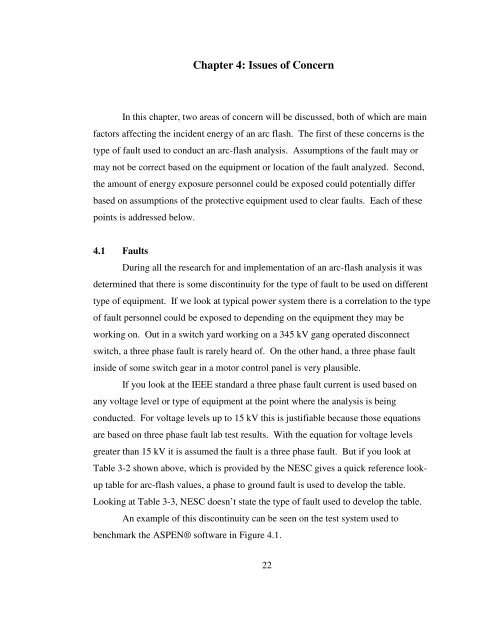arc-flash analysis of utility power systems - Michigan Technological ...
arc-flash analysis of utility power systems - Michigan Technological ...
arc-flash analysis of utility power systems - Michigan Technological ...
Create successful ePaper yourself
Turn your PDF publications into a flip-book with our unique Google optimized e-Paper software.
Chapter 4: Issues <strong>of</strong> Concern<br />
In this chapter, two areas <strong>of</strong> concern will be discussed, both <strong>of</strong> which are main<br />
factors affecting the incident energy <strong>of</strong> an <strong>arc</strong> <strong>flash</strong>. The first <strong>of</strong> these concerns is the<br />
type <strong>of</strong> fault used to conduct an <strong>arc</strong>-<strong>flash</strong> <strong>analysis</strong>. Assumptions <strong>of</strong> the fault may or<br />
may not be correct based on the equipment or location <strong>of</strong> the fault analyzed. Second,<br />
the amount <strong>of</strong> energy exposure personnel could be exposed could potentially differ<br />
based on assumptions <strong>of</strong> the protective equipment used to clear faults. Each <strong>of</strong> these<br />
points is addressed below.<br />
4.1 Faults<br />
During all the rese<strong>arc</strong>h for and implementation <strong>of</strong> an <strong>arc</strong>-<strong>flash</strong> <strong>analysis</strong> it was<br />
determined that there is some discontinuity for the type <strong>of</strong> fault to be used on different<br />
type <strong>of</strong> equipment. If we look at typical <strong>power</strong> system there is a correlation to the type<br />
<strong>of</strong> fault personnel could be exposed to depending on the equipment they may be<br />
working on. Out in a switch yard working on a 345 kV gang operated disconnect<br />
switch, a three phase fault is rarely heard <strong>of</strong>. On the other hand, a three phase fault<br />
inside <strong>of</strong> some switch gear in a motor control panel is very plausible.<br />
If you look at the IEEE standard a three phase fault current is used based on<br />
any voltage level or type <strong>of</strong> equipment at the point where the <strong>analysis</strong> is being<br />
conducted. For voltage levels up to 15 kV this is justifiable because those equations<br />
are based on three phase fault lab test results. With the equation for voltage levels<br />
greater than 15 kV it is assumed the fault is a three phase fault. But if you look at<br />
Table 3-2 shown above, which is provided by the NESC gives a quick reference lookup<br />
table for <strong>arc</strong>-<strong>flash</strong> values, a phase to ground fault is used to develop the table.<br />
Looking at Table 3-3, NESC doesn’t state the type <strong>of</strong> fault used to develop the table.<br />
An example <strong>of</strong> this discontinuity can be seen on the test system used to<br />
benchmark the ASPEN® s<strong>of</strong>tware in Figure 4.1.<br />
22
















